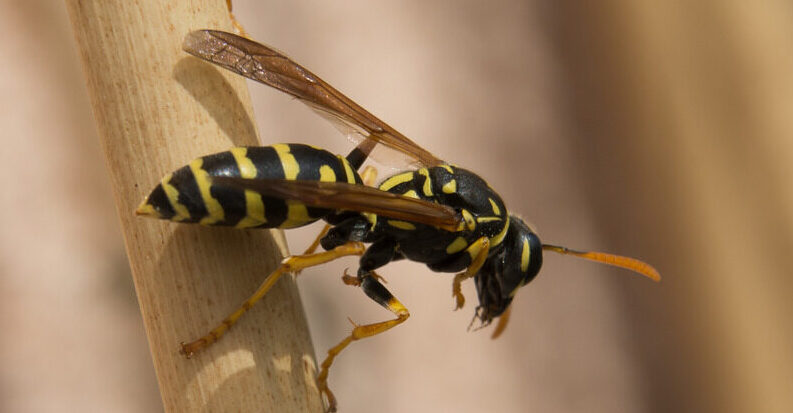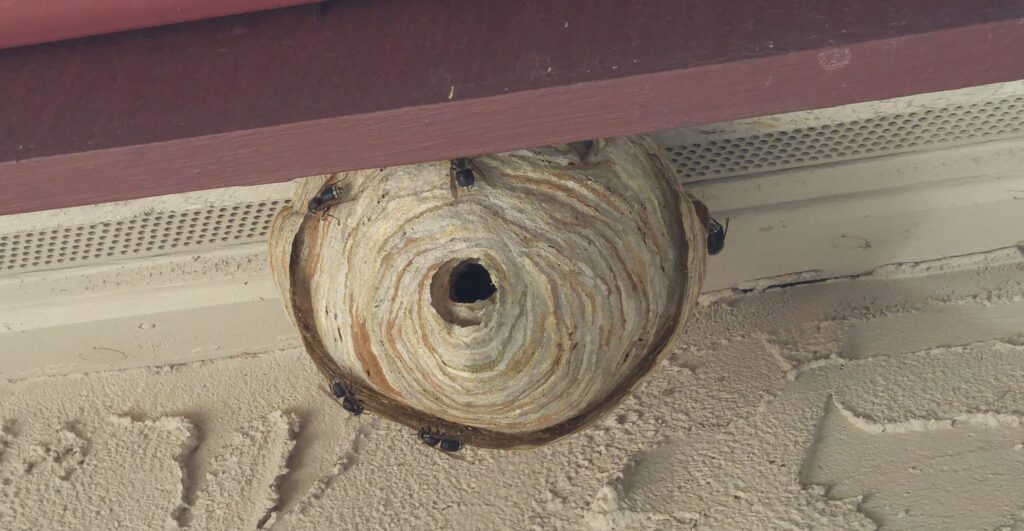Everything about Wasps
| Everything About Wasps | |
|---|---|
| Feature | Description |
| Physical Appearance |
Slender body with a narrow waist. Two pairs of wings (appear as one). Brightly colored, often yellow and black. |
| Habitat |
Nesting Places: Trees, burrows, eaves, inside homes. Distribution: Worldwide, except polar regions. |
| Diet |
Adult Wasps: Nectar Larvae: Insects and spiders. |
| Behavior | Communicate using pheromones for food or danger alerts. |
Dissecting Wasps Anatomy
Head
Thorax
Abdomen
Head
Contains essential sensory organs and mouthparts.
- Antennae: Two long, segmented feelers that detect chemicals, air currents, and vibrations.
- Compound Eyes: Large, multifaceted eyes that provide a wide field of vision.
- Simple Eyes (Ocelli): Usually three, these detect light intensity.
- Mandibles: Strong jaws used for chewing, biting, and manipulating materials.
- Proboscis: A tube-like structure used for feeding on nectar.
Thorax
- Wings: Two pairs, though they often appear as a single pair because they’re locked together during flight.
- Legs: Three pairs, equipped with claws and spines for grasping.
Abdomen
- Stinger: A modified ovipositor used for defense. Delivers venom.
- Spiracles: Tiny openings along the abdomen used for breathing.
How Do I Get Rid Of Wasps?
To address a wasp issue, routinely inspect your property for nests, especially under eaves, ledges, and other sheltered areas. Keep food sources covered and minimize sweet attractions. Ensure potential nesting spots, like ground holes or burrows, are limited.
If the wasp problem persists or is substantial, consider seeking professional Wasp Control services. These specialists offer precise and efficient solutions, guaranteeing immediate mitigation and prevention of subsequent invasions.
What are the most common types of Wasps in Canada?
Canada is home to a diverse range of wasp species due to its vast geographical expanse and varied climates. Here are some of the most common types of wasps you might encounter in Canada:
- Wasps (Hymenoptera)
- Hornets (Vespa)

Wasps

Hornets
Call us for a Free Wasps Inspection
What are the characteristics of Wasps?
| Characteristics of Wasps | |
|---|---|
| Feature | Description |
| Size | Varies by species; typically between 10-30 mm in length. |
| Color | Varies by species; can be black, brown, yellow, or metallic green. |
| Nest | Builds nests made of paper-like material, often found in trees, shrubs, or under eaves. |
| Diet | Primarily carnivorous, feeding on insects, spiders, and other small creatures. Some species also feed on nectar. |
| Behavior | Can be aggressive when defending their nests. Some species live in colonies with a social structure, while others are solitary. |
What are the characteristics of Hornets?
| Characteristics of Hornets | |
|---|---|
| Feature | Description |
| Size | Generally larger than other wasps, with some species reaching up to 2 inches (50 mm) in length. |
| Color | Typically brown or black with yellow or white markings. Their coloration can vary by species. |
| Nest | Builds large, papery nests, often in aerial locations like trees or the eaves of buildings. |
| Diet | Primarily carnivorous, feeding on insects and other arthropods. Adults may also consume nectar. |
| Behavior | Can be aggressive when their nests are threatened. They are social insects that live in colonies with a well-defined caste system. |
Call us for a Free Wasps Inspection
Top Tips To Prevent Wasps Infestations: Essential Guide
- Regular Inspection and Maintenance: Check under eaves, ledges, and other sheltered spots for signs of nests. Seal holes and cracks in walls, roofs, and foundations.
- Keep Food Covered: Ensure food is covered, especially when dining outside. Use garbage cans with tight-fitting lids and clean them regularly.
Limit Potential Nesting Spots: Trim trees and shrubs to reduce sheltered nesting spots. Fill any ground holes or burrows.
Use Natural Repellents: Plant wasp-repelling plants like wormwood, eucalyptus, and mint. Use essential oils like peppermint or citronella in diffusers or sprays.
Install Wasp Traps: Use commercially available wasp traps or make homemade ones using sugary solutions.
Frequently Asked Questions about wasps:
Wasps and bees both belong to the Hymenoptera order, but they have distinct differences. Bees tend to have rounder and fuzzier bodies, while wasps have a more slender shape with a smooth surface. Additionally, bees are primarily herbivores, feeding on nectar and pollen, while many wasps are carnivores or omnivores. Wasps can also be more aggressive than bees, especially when their nest is threatened.
Wasp nests are often made from a papery substance which they produce by chewing wood mixed with saliva. These nests can be found hanging from trees, under eaves, or in other sheltered areas. Bee nests, particularly honeybee hives, are made from beeswax and tend to be more structured with hexagonal cells. Honeybee hives are often in cavities or specially designed hives, while other bees might burrow into the ground or use hollow stems.
